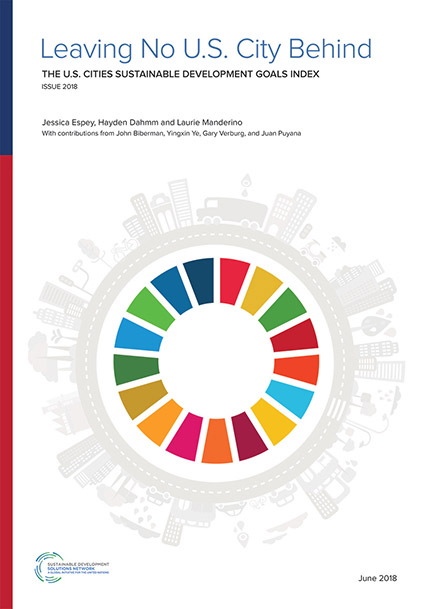More details
Forward
For Mayors and local government leaders across the United States (U.S.) and around the world, the Sustainable Development Goals (SDGs) offer a set of integrated objectives to achieve more prosperous, fair and environmentally sustainable cities. SDG 11 in particular calls for making cities “inclusive, safe, resilient, and sustainable.” The SDGs provide a long-term and non-partisan framework for achieving these bold and worthy objectives.
By measuring progress towards the SDGs, cities gain an important tool, enabling each city to benchmark its progress relative to the goals and to peer communities around the country and the world. The United Nations Sustainable Development Solutions Network (SDSN) is proud to present the 2018 U.S. Cities SDG Index Report as a contribution towards sustainable development in America’s cities. The 100 metropolitan areas examined in this report include 210.9 million inhabitants, constituting 66.2 percent of the U.S. population.
Our hope is that the U.S. Cities SDG Index will not only help cities to benchmark their progress, but also facilitate peer-to-peer exchanges of best practices. We are already seeing the benefits of this exchange in action.
Through networks like the U.S. Conference of Mayors and groups of cities such as San Jose, Baltimore, New York, and Orlando that are working with SDSN to pursue the SDGs, we are seeing an active uptake of the SDGs at the urban level throughout the U.S.
This year’s U.S. Cities SDG Index uses measurements on 15 of the 17 global SDGs to shine a spotlight on many of the challenges that U.S. cities face, such as access to healthcare, obesity, income inequality and violent crime. San Jose-Sunnyvale-Santa Clara metro region in California (CA) achieves the top spot for the second year in a row as the metropolitan area closest to achieving the SDGs, yet it is only 68% of the way to meeting the SDGs overall, highlighting the continued efforts that will be needed in the coming years.
America faces many daunting problems. Gun violence is soaring. The inequality of income and wealth is at all-time highs. Substance abuse and notably the opioid epidemic is claiming vast numbers of lives. Water supplies are unsafe. Greenhouse gas emissions, causing climate change, are at unacceptable levels. And large numbers of young people are ending up with huge student debt yet no four-year- college degree. There is of course progress as well, such as in deploying renewable energy and forging new partnerships between universities and city governments for innovation and job creation.
Federal politics are typically paralyzed these days, in the grips of vested interests and lobbyists that block effective actions. Yet real solutions and progress can still be won at the local and state level. The SDGs encourage cities to find new solutions, and the U.S. Cities SDG Index offers cities a powerful tool for goal setting and measuring progress. With 85 percent of Americans living in cities and metro areas, mayors and local government leaders have the power to usher in a new era of inclusive and sustainable prosperity.
Jeffrey D. Sachs
Director, Sustainable Development Solutions Network
Acknowledgements
The authors are very grateful for advice and feedback from several colleagues and partners. Particular thanks go to Guido Schmidt-Traub for his thoughtful comments and guidance throughout, and to Professor Jeffrey Sachs who led this project in 2017 and inspired the 2018 edition. Thanks also to Grayson Fuller, Guillaume Lafortune and Mihir Prakash for their technical assistance. In addition, the authors would like to thank Rekha Raghunathan and Vikrant MS from IIHS for copy-editing and designing the report. The authors would like to acknowledge Solomon Greene and colleagues at the Urban Institute for the brilliant work they did on available indicators for local SDG monitoring in their publication “Hacking the Sustainable Development Goals: Can US Cities Measure Up?” Finally, the authors would like to thank the Kresge Foundation for their generous support for the production of this report.
